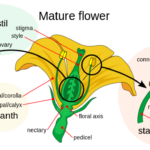Parts Of A Flower
Flowers are not just beautiful; they are fascinating structures that play a crucial role in plants’ life cycles.
Petals: Often brightly colored, petals attract pollinators such as bees, butterflies, and birds.
Sepals: These green, leaf-like parts encase and protect the flower bud before it blooms.
Stamen: The male reproductive part of the flower, consisting of two main parts:
- Anther: Produces pollen, which contains the male gametes (sperm cells).
- Filament: A stalk that holds the anther in place.
Pistil (or Carpel): The female reproductive part of the flower, consisting of three main parts:
- Stigma: The sticky surface at the top of the pistil that captures pollen.
- Style: The tube-like structure that connects the stigma to the ovary.
- Ovary: Contains ovules
Ovule: Each ovule inside the ovary contains a female gamete (egg cell). After fertilization, the ovule develops into a seed.
Nectary: Produces nectar, a sugary substance that attracts pollinators.
Receptacle: The part of the stem where the flower’s organs are attached.
Flower Adaptations
Petals’ Secret Code:
- Petals often have unique patterns and colors, known as “nectar guides,” which are invisible to humans but can be seen by pollinators like bees.
- These guides help direct the insects to the flower’s nectar, ensuring pollination.
Other Adaptations:
- Some flowers can change shape! The petals of the Snapdragon flower act like a trap, opening only when a pollinator of the right weight lands on them.
- Flowers like the Hydrangea can change color based on the soil’s pH level. In acidic soils, they bloom blue, while in alkaline soils, they bloom pink.
Fun Facts
Here are some interesting facts about flowers:
- The Titan Arum produces a foul odor resembling rotting flesh. This smell attracts carrion-eating insects, which then help pollinate the plant.
- Many flowers are hermaphroditic, meaning they contain both male (stamens) and female (pistils) reproductive organs, allowing them to self-pollinate.
- Sunflowers grow up to 12 feet tall and are known to follow the sun across the sky, a behavior called heliotropism.
Review
Let’s quickly recap what we learned about the anatomy of a flower:
- What are the main parts of the stamen? Anther & Filament
- What part of the flower becomes the seed after fertilization? Ovule
- What is the sticky surface that captures pollen called? Stigma
- What part of the flower protects the bud before it opens? Sepal


Recent Comments